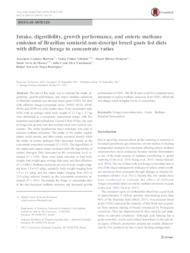Intake, digestibility, growth performance, and enteric methane emission of Brazilian semiarid non-descript breed goats fed diets with different forage to concentrate ratios.
Intake, digestibility, growth performance, and enteric methane emission of Brazilian semiarid non-descript breed goats fed diets with different forage to concentrate ratios.
Author(s): BARBOSA, A. L.; VOLTOLINI, T. V.; MENEZES, D. R.; MORAES, S. A. de; NASCIMENTO, J. C. S.; RODRIGUES, R. T. de S.
Summary: The aim of this study was to evaluate the intake, di-gestibility, growth performance, and enteric methane emissions of Brazilian semiarid non-descript breed goats (NDG) fed diets with different forage:concentrate ratios (100:0, 80:20, 60:40, 40:60, and 20:80) on a dry matter basis. Forty uncastrated male NDG with an average initial body weight of 13.3 kg ± 4.7 kg were distributed in a completel y randomized design, with five treatments and eight replications. Ground Tifton-85 hay was used as forage and ground corn and soybean meal were used as con-centrate. The sulfur hexafluoride tracer technique was used to measure methane emissions. The intake of dry matter, organic matter, crude protein, and ether extract increased linearly while the intake of neutral detergent fiber decreased linearly as the concentrate proportion increased (P< 0.05). The digestibility of dry matter and organic matter increased while the digestibility of neutral detergent fiber decreased as the concentrate level in-creased (P< 0.05). There were linear increases in final body weight, total weight gain, average daily gain, and feed efficiency (P< 0.0001). Methane emissions per unit of body weight (rang-ing from 1.9 to 0.5 g/kg), metabolic body weight (ranging from 3.9 to 1.2 g/kg), and dry matter intake (ranging from 58.8 to 21.9 g/kg) reduced linearly as the concentrate proportion in-creased (P< 0.01). Decreasing the forage to concentrate ratioin the diet decreased methane emission and increased growth performance of NDG. The 80:20 ratio could be considered more appropriate to reduce methane emissions from NDG, which did not change much at higher levels of concentrate.
Publication year: 2018
Types of publication: Journal article
Unit: Embrapa Semi-arid Region
Observation
Some of Embrapa's publications are published as ePub files. To read them, use or download one of the following free software options to your computer or mobile device. Android: Google Play Books; IOS: iBooks; Windows and Linux: Calibre.
Access other publications
Access the Agricultural Research Database (BDPA) to consult Embrapa's full library collection and records.
Visit Embrapa Bookstore to purchase books and other publications sold by Embrapa.

